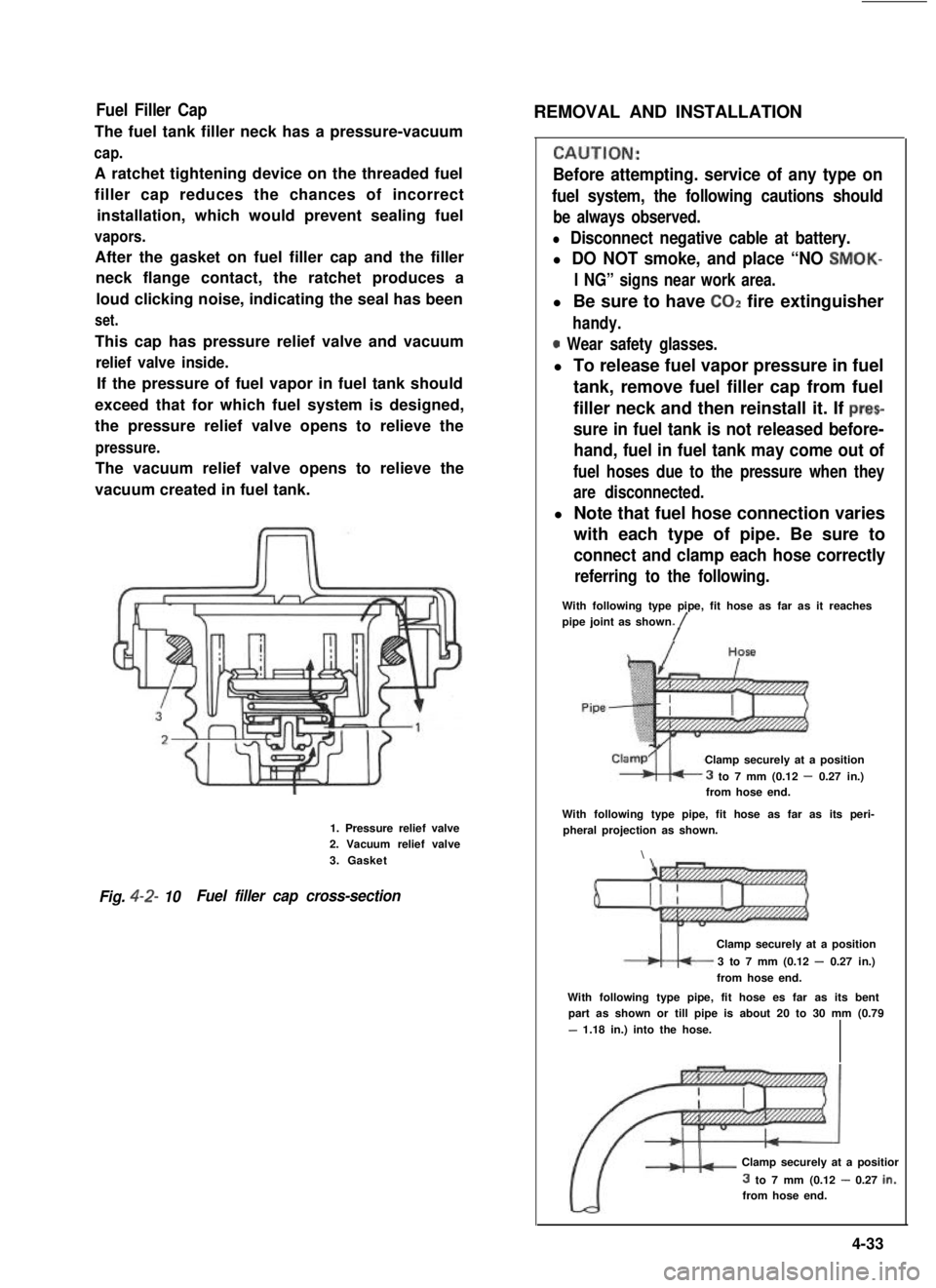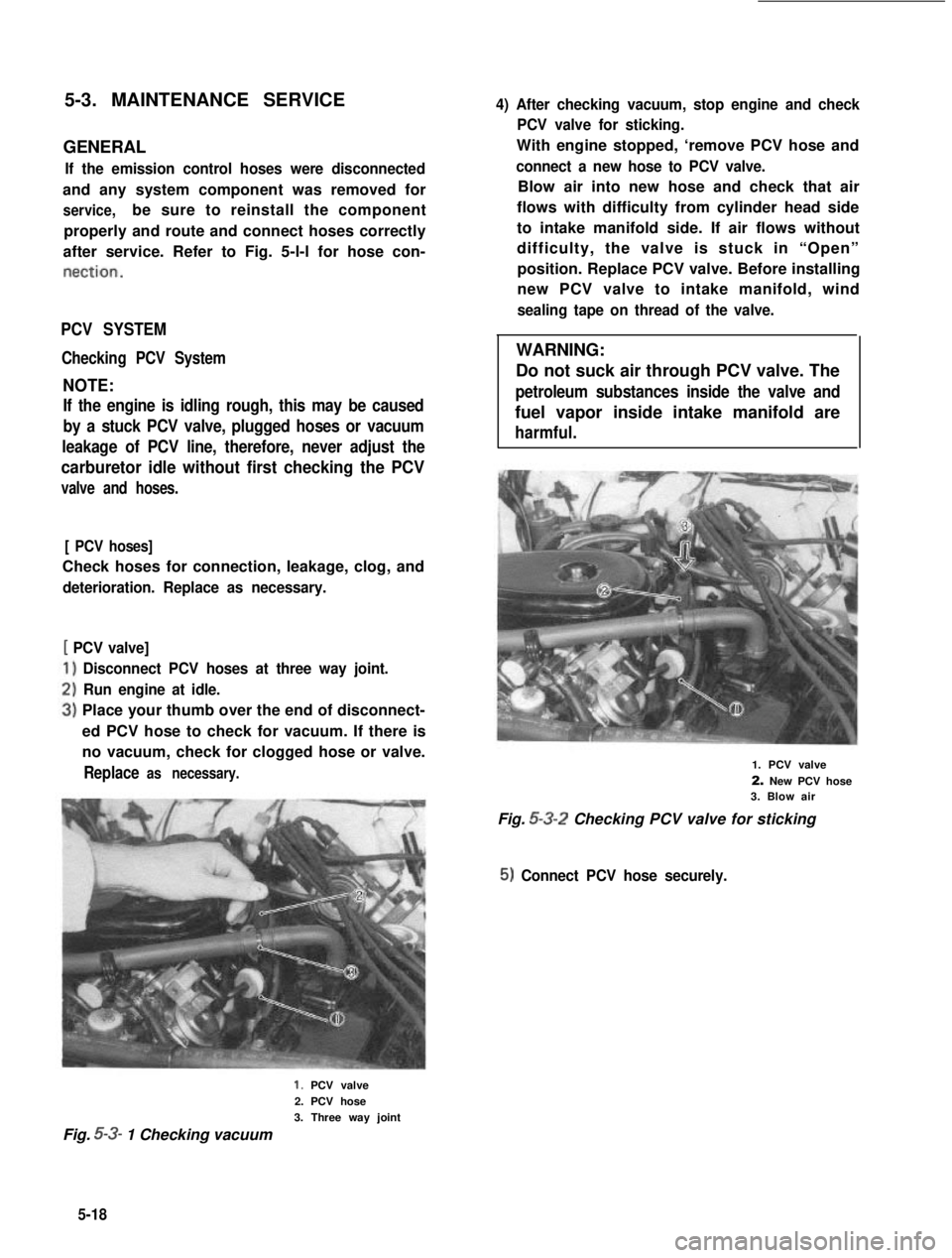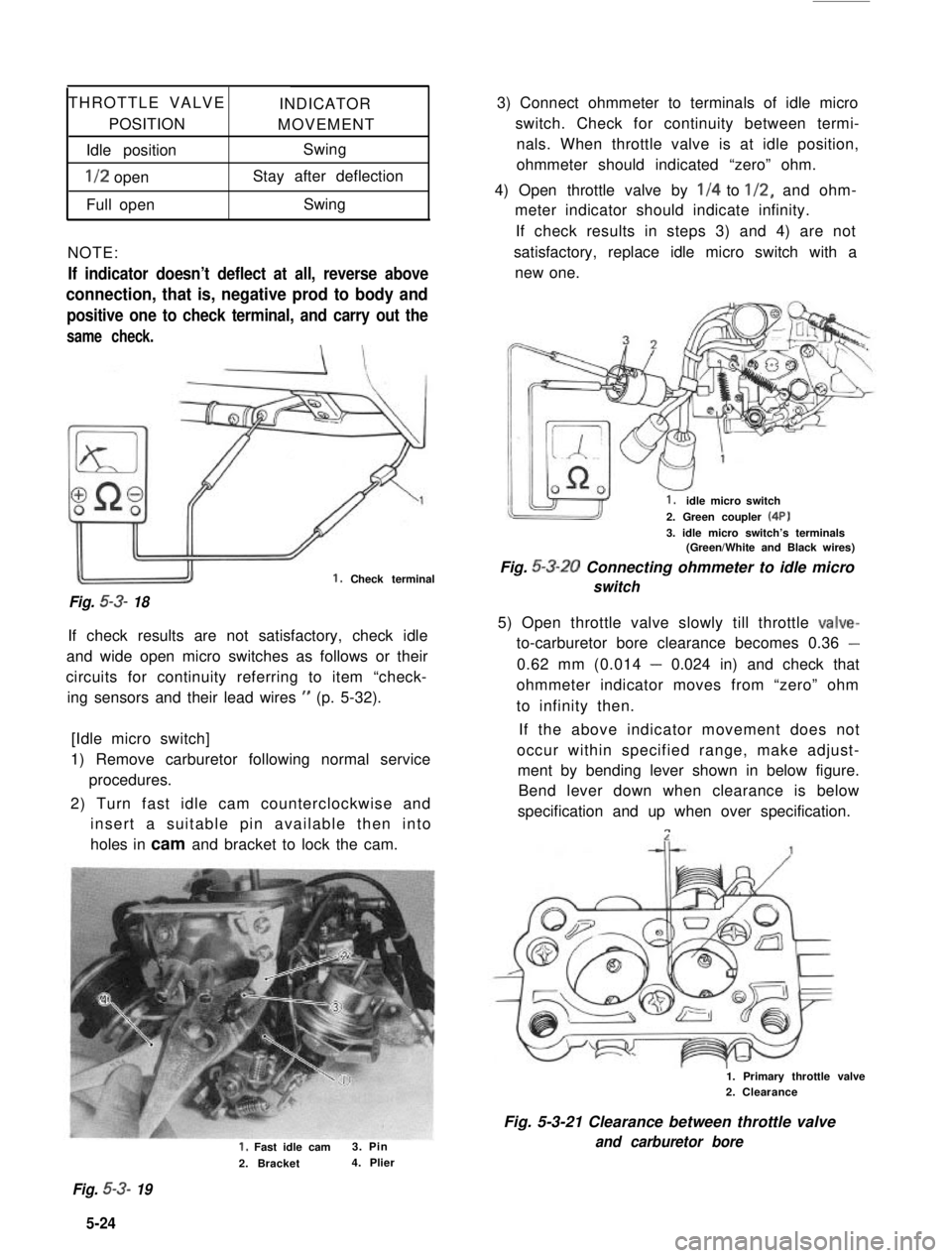1987 SUZUKI GRAND VITARA service
[x] Cancel search: servicePage 148 of 962

Fuel Filler Cap
The fuel tank filler neck has a pressure-vacuum
cap.
A ratchet tightening device on the threaded fuel
filler cap reduces the chances of incorrect
installation, which would prevent sealing fuel
vapors.
After the gasket on fuel filler cap and the filler
neck flange contact, the ratchet produces a
loud clicking noise, indicating the seal has been
set.
This cap has pressure relief valve and vacuum
relief valve inside.
If the pressure of fuel vapor in fuel tank should
exceed that for which fuel system is designed,
the pressure relief valve opens to relieve the
pressure.
The vacuum relief valve opens to relieve the
vacuum created in fuel tank.
1. Pressure relief valve2. Vacuum relief valve
3. Gasket
Fig. 4-2- 10Fuel filler cap cross-section
REMOVAL AND INSTALLATION
CALJTION:
Before attempting. service of any type on
fuel system, the following cautions should
be always observed.
l Disconnect negative cable at battery.
l DO NOT smoke, and place “NO SMOK-
I NG” signs near work area.
l Be sure to have COZ fire extinguisher
handy.
0 Wear safety glasses.
l To release fuel vapor pressure in fuel
tank, remove fuel filler cap from fuel
filler neck and then reinstall it. If prec
sure in fuel tank is not released before-
hand, fuel in fuel tank may come out of
fuel hoses due to the pressure when they
are disconnected.
l Note that fuel hose connection varies
with each type of pipe. Be sure to
connect and clamp each hose correctly
referring to the following.
With following type pipe, fit hose as far as it reachespipe joint as shown./
Clamp securely at a position
3 to 7 mm (0.12 - 0.27 in.)from hose end.
With following type pipe, fit hose as far as its peri-pheral projection as shown.
\
Clamp securely at a position
3 to 7 mm (0.12 - 0.27 in.)
from hose end.
With following type pipe, fit hose es far as its bentpart as shown or till pipe is about 20 to 30 mm (0.79
- 1.18 in.) into the hose.
Clamp securely at a positior
3 to 7 mm (0.12 - 0.27 in.:from hose end.
4-33
Page 150 of 962
![SUZUKI GRAND VITARA 1987 Service Repair Manual [Fuel tank purging procedure]
WARNING:
This purging procedure will NOT remove
all fuel vapor. Do not attempt any repair
on tank where heat or flame is required, as
an explosion resulting in personal i SUZUKI GRAND VITARA 1987 Service Repair Manual [Fuel tank purging procedure]
WARNING:
This purging procedure will NOT remove
all fuel vapor. Do not attempt any repair
on tank where heat or flame is required, as
an explosion resulting in personal i](/manual-img/20/57437/w960_57437-149.png)
[Fuel tank purging procedure]
WARNING:
This purging procedure will NOT remove
all fuel vapor. Do not attempt any repair
on tank where heat or flame is required, as
an explosion resulting in personal injury
cou Id occur.J
The following procedure is used for purging the
fuel tank.
1) After removing fuel tank, remove all hoses,
fuel level gauge from fuel tank.
2) Drain all remaining fuel from tank.
3) Move tank to flushing area.
4) Fill tank with warm water or tap water, and
agitate vigorously and drain. Repeat this
washing until inside of tank is clean.
Replace tank if inside is rusty.
5) Completely flush out remaining water after
washing.
[ Installation]
Reverse removal procedure for installation using
care for the following.
Tightening torque30-45 Nm
for fuel tank(3.0- 4.5 kg-m)
drain plug(22.0 - 32.5 lb-ft)
Refer to Fig. 4-2-5 for piping and clamp posi-
tions.
l Make sure for correct hose-to-pipe connec-
tion.
l Clamp hoses securely.
l Upon completion of installation, start engine
and check hose joints for leaks.
MAINTENANCE SERVICES
Fuel Lines
Visually inspect fuel lines and connections for
evidence of fuel leakage, hose cracking, and
damage. Make sure all clamps are secure.
Repair leaky joints, if any.
Replace hoses that are suspected of being crack-
ed.
Fig. 4-2-14
Fuel Filler (tank) Cap
Visually inspect gasket of fuel filler cap.
If it is damaged or deteriorated, replace filler cap
with new one.
NOTE:
If cap requires replacement, only a cap with
the same features should be used. Failure to
use correct cap can result in a serious malfunc-
tion of the system.
Fig. 4-2-15
1. Fuel filler cap
2. Fuel filler capgasket
Fuel Filter
As said before, this filter does not permit dis-
assembly: it is to be replaced with a new one
periodically.
Replace fuel filter referring to previous item of
“Fuel Filter Removal and Installation”.
This servicing must be performed in a well
ventilated area and away from any open
flames (such as gas hot water heaters).
4-35
Page 152 of 962

SECTION 5
EMISSION CONTROL SYSTEM
CONTENTS
5-1.GENERAL DESCRlPTlOk........................................5-4
POSITIVE CRANKCASE VENTILATION (PCV) SYSTEM........... ..5-5
THERMOSTATICALLY CONTROLLED AIR CLEANER
(TCAC) SYSTEM................................................5-6
EVAPORATIVE EMISSION CONTROL SYSTEM.....................5-7
HOT IDLE COMPENSATOR (HIC)..................................5-8
DECELERATION MIXTURE CONTROL SYSTEM....................5-9
COMPUTER CONTROLLED EMISSION CONTROL SYSTEM.........5-10
BOWL VENTILATION SYSTEM..................................5-12
FUEL CUT SYSTEM..........................................5-13
EXHAUST GAS RECIRCULATION (EGR) SYSTEM..................5-14
5-2.DIAGNOSIS......................................................5-15
5-3.MAINTENANCE SERVICE......................................5-18
PCV SYSTEM..............................................5-18
TCAC SYSTEM..............................................5-19
EVAPORATIVE EMISSION CONTROL SYSTEM...................5-20
HOT IDLE COMPENSATOR (HIC).................................5-21
DECELERATION MIXTURE CONTROL SYSTEM..................5-21
FEED BACK SYSTEM........................................5-22
SWITCH VENT SOLENOID....................................5-36
FUEL CUT SYSTEM..........................................5-36
EGR SYSTEM...............................................5-37
GENERAL..................................................5-18
5-1
5
Page 169 of 962

5-3. MAINTENANCE SERVICE
GENERAL
If the emission control hoses were disconnected
and any system component was removed for
service,be sure to reinstall the component
properly and route and connect hoses correctly
after service. Refer to Fig. 5-l-l for hose con-
nection.
PCV SYSTEM
Checking PCV System
NOTE:
If the engine is idling rough, this may be caused
by a stuck PCV valve, plugged hoses or vacuum
leakage of PCV line, therefore, never adjust the
carburetor idle without first checking the PCV
valve and hoses.
[ PCV hoses]
Check hoses for connection, leakage, clog, and
deterioration. Replace as necessary.
[ PCV valve]
Disconnect PCV hoses at three way joint.
Run engine at idle.
Place your thumb over the end of disconnect-
ed PCV hose to check for vacuum. If there is
no vacuum, check for clogged hose or valve.
Replace as necessary.
4) After checking vacuum, stop engine and check
PCV valve for sticking.
With engine stopped, ‘remove PCV hose and
connect a new hose to PCV valve.
Blow air into new hose and check that air
flows with difficulty from cylinder head side
to intake manifold side. If air flows without
difficulty, the valve is stuck in “Open”
position. Replace PCV valve. Before installing
new PCV valve to intake manifold, wind
sealing tape on thread of the valve.
WARNING:
Do not suck air through PCV valve. The
petroleum substances inside the valve and
fuel vapor inside intake manifold are
harmful.
1. PCV valve
2. New PCV hose3. Blow air
Fig. 5-3-2 Checking PCV valve for sticking
5) Connect PCV hose securely.
1. PCV valve
2. PCV hose
3. Three way joint
Fig. 5-3- 1 Checking vacuum
5-18
Page 175 of 962

THROTTLE VALVEINDICATOR
POSITIONMOVEMENT
Idle positionSwing
l/2 openStay after deflection
Full openSwing
NOTE:
If indicator doesn’t deflect at all, reverse above
connection, that is, negative prod to body and
positive one to check terminal, and carry out the
same check.
Fig. 53- 18
1. Check terminal
If check results are not satisfactory, check idle
and wide open micro switches as follows or their
circuits for continuity referring to item “check-
ing sensors and their lead wires ” (p. 5-32).
[Idle micro switch]
1) Remove carburetor following normal service
procedures.
2) Turn fast idle cam counterclockwise and
insert a suitable pin available then into
holes in cam and bracket to lock the cam.
1, Fast idle cam3. Pin
2. Bracket4. Plier
3) Connect ohmmeter to terminals of idle micro
switch. Check for continuity between termi-
nals. When throttle valve is at idle position,
ohmmeter should indicated “zero” ohm.
4) Open throttle valve by l/4 to l/2, and ohm-
meter indicator should indicate infinity.
If check results in steps 3) and 4) are not
satisfactory, replace idle micro switch with a
new one.
1.idle micro switch
2. Green coupler (4P)
3. idle micro switch’s terminals(Green/White and Black wires)
Fig. 5-3-20 Connecting ohmmeter to idle micro
switch
5) Open throttle valve slowly till throttle valve-
to-carburetor bore clearance becomes 0.36 -
0.62 mm (0.014 - 0.024 in) and check that
ohmmeter indicator moves from “zero” ohm
to infinity then.
If the above indicator movement does not
occur within specified range, make adjust-
ment by bending lever shown in below figure.
Bend lever down when clearance is below
specification and up when over specification.
n
1. Primary throttle valve2. Clearance
Fig. 5-3-21 Clearance between throttle valve
and carburetor bore
Fig. 5-3- 19
5-24 4
Page 176 of 962
![SUZUKI GRAND VITARA 1987 Service Repair Manual Fig. 5-3-22 Lever
1. Lever
.
[Wide open micro switch]
1) Connect ohmmeter to wide open micro
switch as indicated in below figure.
At this time, ohmmeter indicator should
indicate “zero” ohm.
2) Wh SUZUKI GRAND VITARA 1987 Service Repair Manual Fig. 5-3-22 Lever
1. Lever
.
[Wide open micro switch]
1) Connect ohmmeter to wide open micro
switch as indicated in below figure.
At this time, ohmmeter indicator should
indicate “zero” ohm.
2) Wh](/manual-img/20/57437/w960_57437-175.png)
Fig. 5-3-22 Lever
1. Lever
.
[Wide open micro switch]
1) Connect ohmmeter to wide open micro
switch as indicated in below figure.
At this time, ohmmeter indicator should
indicate “zero” ohm.
2) When throttle valve is fully opened, ohmmeter
should indicate infinity.
If any defect, replace.
1. Wide open micro switch
2. Yellow coupler
3. Green coupler (4P)4. Wide open micro switch’sterminals(Green and Black/Yellow wires)
Fig. 5-3-23 Checking wide open micro switch
3) Open throttle valve gradually until the ohm-
meter indicates infinity. Then, using a vernier,
measure the clearance between throttle valve
and carburetor bore as shown in below figure.
The clearance should be within 6.0 - 7.2 mm
(0.24- 0.28 in). If the clearance is out of
specified range, make adjustment by bending
the lever in below figure.
1. Primary throttle valve2. Clearance
Fig. 5-3-24 Clearance between throttle valve
and carburetor bore
1. Wide open micro switch lever
Fig. 5-3-25 Wide open micro switch lever
Upon completion of checks, install carburetor
following normal service procedures.
Checking mixture control solenoid valve
1) Check to make sure that ignition switch is at
“OFF” position.
2) Disconnect couplers from ECM, TWSVs and
vsv.
3) Disconnect mixture control solenoid valve
lead wires at the coupler (5P).
Fig. 5-3-26
1. Green coupler (BP)
5-25
Page 191 of 962

SECTION 6
ENGINE COOLING SYSTEM
CONTENTS
6-l. GENERAL DESCRIPTION .. . . . . . . . . . . . . . . . . . . . ..m..*.........6-2
6-2. REMOVAL...............................................6-5
6.3. INSPECTION OF COMPONENTS..............................6-7
THERMOSTAT...........................................6-7
RADIATOR..............................................6-8
WATER PUMP............................................6-8
6-4.IMPORTANT STEPS FOR REINSTALLATION....................6-9
WATER PUMP..............................................6-9
THERMOSTAT.............................................6-9
COOLING FAN AND WATER PUMP BELT.......................6-9
RADIATOR................................................6-10
6-5. MAINTENANCE SERVICE. . . . . . . . . . . . . . . . . . . . . . . . . . . . . . . . . ...6-10
WATER PUMP BELT.........................................6-10
COOLANT..............................................6-11
COOLANT LEVEL........................................6-11
COOLING SYSTEM SERVICE. . . . . . . . . . . . . . . . . . . . . . . . . . . . . . . .6-12
COOLING SYSTEM, FLUSH AND REFILL . . . . . . . . . . . . . . . . . . . . . . 6-12
6-1
6
Page 200 of 962

Radiator6-5. MAINTENANCE SERVICE
1) Tighten bolts securely for proper installa-
tion. Also, fix joints of 2 hoses with clamps.
Fig. 6-22
2) Install radiator shroud and cooling fan &
clutch at the same time.
3) Tighten shroud bolts and fan clutch nuts.
4) Adjust water pump belt tension.
5) Fill specified amount of coolant.
Water Pump Belt
1) Inspect belt for cracks, cuts, deformation,
wear and cleanliness. If it is necessary to
replace belt, refer to ~6-5 for procedure.
2) Check belt for tension. Belt is in proper
tension when it deflects 6 to 9 mm (0.24 -
0.35 in.) under thumb pressure (about 10 kg
or 22 lb.).
Belt tension
specification
6 - 9 mm (0:24 - 0.35 in.)
as deflectionI
Water pump pulley
Crankshaft pulley
Fig. 623
3) If belt is too tight or too loose, adjust it to
proper tension by displacing alternator
position.
Fig. 6-
4) Tighten alternator adjusting bolt and pivot
bolt.
WARNING:
All adjustments described above are to be
performed with ENGINE NOT RUNNING.
6-10